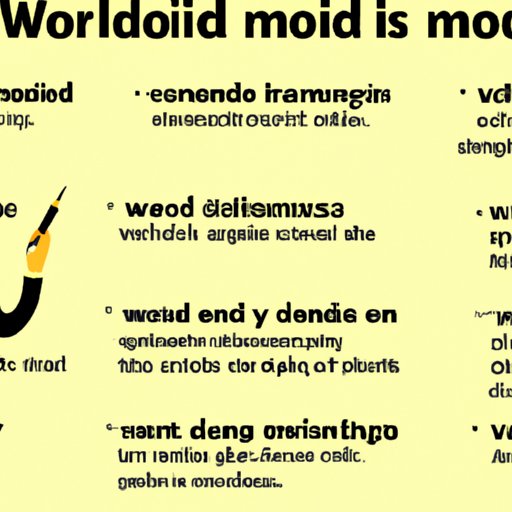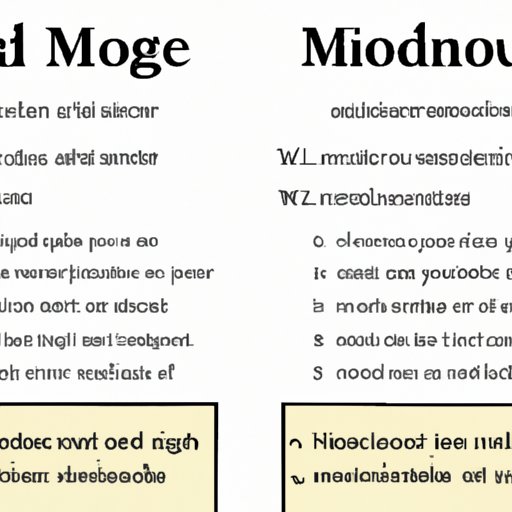Introduction
A mode of writing refers to the style, purpose and audience of a particular piece of writing. It can be formal or informal, academic or professional, creative or descriptive. Understanding the different modes of writing can help you develop your writing skills and communication abilities.

A Guide to Different Modes of Writing
There are many different types of writing that can be used for various purposes. Each type has its own set of rules and guidelines that must be followed in order to create an effective piece of writing. The following are some of the most common types of writing:
Expository Writing
Expository writing is used to explain or inform. This type of writing often includes facts and figures and is typically used for reports, essays, research papers and other technical documents. Expository writing should be clear and concise, and it should provide readers with all the information they need to understand the subject matter.
Narrative Writing
Narrative writing is used to tell stories. This type of writing usually includes characters, plot, setting and dialogue. Narratives can be fiction or non-fiction, and they can be written in first or third person. They can also be written in any genre, from horror to romance.
Persuasive Writing
Persuasive writing is used to convince readers to take a certain action or to believe in a certain idea. This type of writing typically includes strong arguments, evidence and an emotional appeal. Persuasive writing is often used in advertising and political campaigns.
Descriptive Writing
Descriptive writing is used to describe a person, place or thing. This type of writing usually includes vivid details and sensory language to help readers experience the subject as if they were there. Descriptive writing is often used in novels, short stories and other works of fiction.
Creative Writing
Creative writing is used to express feelings, thoughts and ideas. This type of writing often includes elements of fiction, such as characters, plot and dialogue. Creative writing is often used in poetry, plays, screenplays and short stories.
Exploring the Different Types of Writing
Now that you have an overview of the different types of writing, let’s take a closer look at each one. Analyzing each type of writing can help you understand the purpose of each and how to use them effectively.
Analyzing Each Type of Writing
When analyzing each type of writing, consider the following questions: What is the purpose of this type of writing? Who is the intended audience? How can I make my writing engaging and convincing?
Understanding the Purpose of Each Type
Each type of writing has a specific purpose. Expository writing is used to explain or inform, narrative writing is used to tell stories, persuasive writing is used to convince readers and descriptive writing is used to describe a person, place or thing. Creative writing is used to express feelings, thoughts and ideas.
An Overview of Writing Modes
In addition to the different types of writing, there are also different modes of writing. Modes of writing refer to the style and tone of the writing. Some of the most common modes of writing include formal, informal, academic and professional.
Formal Writing
Formal writing is used for official documents and other serious pieces of writing. This type of writing should be clear, accurate and precise. It should follow the accepted conventions of grammar, punctuation and spelling.
Informal Writing
Informal writing is used for more casual pieces of writing, such as emails and letters. This type of writing can be more relaxed and conversational than formal writing, but it should still follow the basic rules of grammar and punctuation.
Academic Writing
Academic writing is used for scholarly articles, textbooks and other scholarly pieces of writing. This type of writing should be objective and should present information in a clear and logical manner. Academic writing should also adhere to the accepted conventions of grammar and punctuation.
Professional Writing
Professional writing is used for business documents, such as resumes, cover letters and reports. This type of writing should be clear and concise, and it should use language that is appropriate for the intended audience. Professional writing should also adhere to the accepted conventions of grammar and punctuation.

Modes of Writing: What You Need to Know
Knowing the different modes of writing can help you become a better writer. Understanding the differences in style and tone can help you develop a sense of voice that is appropriate for the intended audience. Learning the rules of grammar and punctuation can also help you communicate effectively.

How to Choose the Right Mode of Writing
Choosing the right mode of writing can be difficult. Here are some tips to help you select the best mode for your piece of writing:
Identifying Your Audience
The first step is to identify your audience. Knowing who will be reading your writing can help you determine the appropriate mode of writing. For example, if you are writing for a professional audience, you may want to use a more formal style of writing.
Considering Your Topic
You should also consider your topic when selecting a mode of writing. For example, if you are writing about a scientific topic, you may want to use a more formal, academic style of writing. On the other hand, if you are writing about a personal experience, you may want to use a more informal style.
Establishing Your Goal
Finally, you should consider your goal when selecting a mode of writing. If you are trying to persuade your readers to take a certain action, you may want to use a more persuasive style of writing. If you are trying to entertain your readers, you may want to use a more creative style.

The Benefits of Each Writing Mode
Using the right mode of writing can help you achieve your goals. Knowing and utilizing different modes of writing can also have many other benefits, such as:
Enhancing Your Writing Skills
Learning the different modes of writing can help you become a better writer. Being able to recognize and utilize the different styles can help you write more effectively, no matter what the situation.
Improving Communication
Using the right mode of writing can help you communicate more effectively. Knowing how to choose the right words and phrases can help you get your message across in a clear and concise manner.
Increasing Your Knowledge
Learning the different modes of writing can also help you increase your knowledge. Knowing the rules and conventions of each type of writing can help you become a better reader as well as a better writer.
Tips for Selecting the Right Writing Mode
Selecting the right mode of writing can be challenging, but here are some tips to help you make the right choice:
Research the Different Types of Writing
Take the time to research the different types of writing and their associated rules and conventions. Doing so can help you understand the differences between each type of writing and how to use them effectively.
Experiment with Different Writing Styles
Don’t be afraid to experiment with different writing styles. Trying out different modes of writing can help you find the one that best suits your needs.
Exercise Caution When Combining Writing Modes
Be careful when combining different modes of writing. Make sure that the combination of styles is appropriate for the intended audience and the subject matter.
Conclusion
Modes of writing refer to the style, purpose and audience of a particular piece of writing. Understanding the different types of writing and the different modes of writing can help you become a better writer and communicator. Knowing how to select the right mode of writing can help you achieve your goals and connect with your audience.
(Note: Is this article not meeting your expectations? Do you have knowledge or insights to share? Unlock new opportunities and expand your reach by joining our authors team. Click Registration to join us and share your expertise with our readers.)
